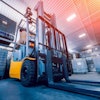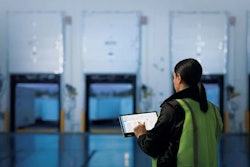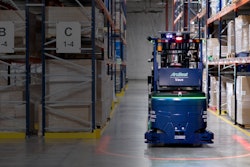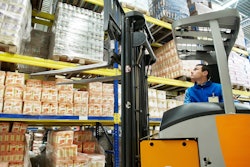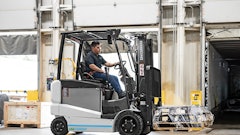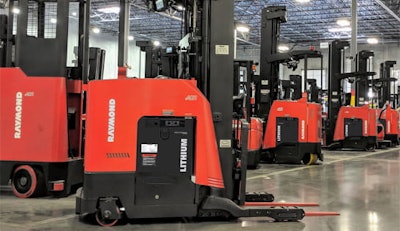
If you’re not already familiar with integrated data solutions and new sustainability initiatives, now is the time to optimize your current supply chain operations. From greater fleet connectivity to operator assist technologies to investing in electrification solutions, industry leaders need to think boldly — and quickly — to maximize productivity and combat new challenges.
Above all, two key trends stand out as we kick-start 2024: intralogistics solutions that prioritize connectivity through data, and sustainability measures that improve energy efficiency while minimizing environmental impact.
The rise of interconnectivity through Industry 4.0
With a variety of applications, processes, systems and management strategies designed to capture data, it can be easy to lose sight of the bigger picture: Why are we collecting this information, and how can that information improve our operations? Is it enough to simply track time, equipment and energy usage separately to increase productivity where inefficiencies exist?
Under the principles of Industry 4.0, the answer is clear: It’s not.
Instead of simply flagging and solving challenges that arise, interconnected data allows us to understand the ways in which various systems contribute to those challenges in the first place. If a particular lift truck is experiencing greater wear and tear than other equipment, the tenets of Industry 4.0 can help pinpoint better long-term solutions. For example, if we know which specific routes, loads or operator behaviors are contributing to faster tire degradation, we can then create targeted maintenance strategies that extend the life span of our equipment and reduce downtime all at once.
In short, when we can analyze and understand our operations more holistically, we’re able to take greater advantage of the data at our fingertips to create previously unseen efficiencies and solve problems before they become an issue — not after.
Optimize operations through improved operator confidence and comfort
Connectivity also helps to reinforce best practices among operators and invest in new assist technologies that can increase productivity.
Many facility managers can relate to the challenges posed by overseeing a small pool of qualified, experienced operators who must constantly train new hires to get them up to speed.
Learning based in virtual reality, for example, can help new hires become more capable and confident in basic lift truck operation. When operators make the transition to full lift truck use, other tools — such as location systems or object detection systems — are designed to offer valuable peace of mind. Location systems enhance security, efficiency and productivity by offering the ability to track, locate, monitor and control the movements of lift trucks within user-defined zones and by tracking personnel and assets in your warehouse. Object detection systems are designed to alert lift truck operators when an object is detected in the travel path.
Location systems also can be combined with fleet management tools to allow supervisors to remotely manage operator vehicle access and offer instant feedback on performance metrics.
Solving for labor challenges like these only becomes more important as we move toward peak e-commerce season. By collecting and analyzing data across systems, facilities and processes, warehouse managers can better prepare for increased supply chain strain and demand, and operators can feel confident knowing that a range of technologies, tools and systems will help them complete the job.
Championing sustainability to stay ahead of supply chain trends
Sustainability is now a core tenet of maximizing supply chain productivity.
Take, for instance, the rise of lithium-ion batteries as a means to achieve faster fleet charging, longer run-times, superior capacity retention and greater efficiency all while lowering total cost. Improved battery chargers and battery handling systems can help reduce turnaround time and ensure proper operator handling and servicing when storing energy equipment. Through lithium-ion and other forklift battery system solutions, facility owners can enhance warehouse output while meeting valuable sustainability goals.
Of course, lithium-ion is just one example of a larger electrification revolution happening within and outside the forklift industry. In the past, supply chain leaders were posed with difficult questions: Should they transition to alternative energy solutions to comply with evolving sustainability standards while taking a loss on productivity and profit, or should they prioritize efficiency while sacrificing important energy and consumption goals?
New energy trends and solutions offer a different answer. Instead of an either-or scenario, transitioning to electrification can now serve as a yes-and solution. In addition to lithium-ion batteries — which have simultaneously become more powerful and cost-friendly — new energy solutions such as solar panels and stationary energy storage systems can effectively transform warehouses into controllable energy hubs optimized for both normal and peak operations.
Stay ahead of data and energy trends to combat supply chain challenges
Choosing to tackle trends head-on is the best way to ensure your facilities remain productive, efficient and lean. As data collection systems evolve and grow, it’s not enough to simply collect information in silos. Instead, digging deeper to uncover the “why” behind labor challenges and supply chain disruptions is key to optimizing operations and mitigating problems before they arise.
Similarly, transitioning to alternative energy solutions such as lithium-ion now can help your workforce adapt to and prepare for the incoming electrification revolution before your systems, applications and processes become inefficient.
By considering working with an end-to-end intralogistics solutions provider, you can solve for the unique challenges your operation faces while continuing to prioritize productivity, operator security and sustainability — all while preparing for the future of an industry that, above all, is defined by change.


